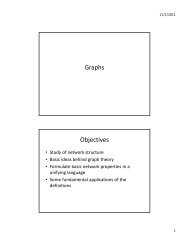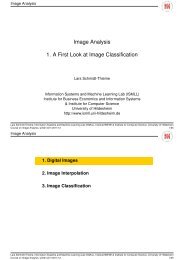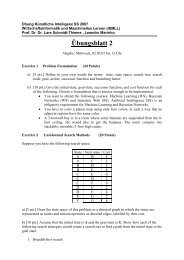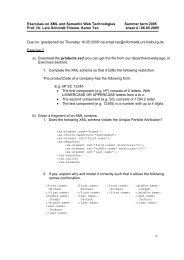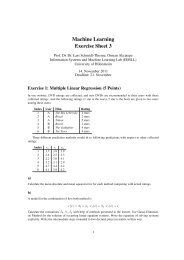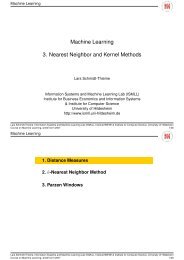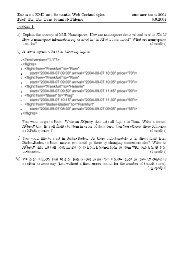A Set Theoretical Method for Video Synopsis - ACM Digital Library
A Set Theoretical Method for Video Synopsis - ACM Digital Library
A Set Theoretical Method for Video Synopsis - ACM Digital Library
Create successful ePaper yourself
Turn your PDF publications into a flip-book with our unique Google optimized e-Paper software.
A <strong>Set</strong> <strong>Theoretical</strong> <strong>Method</strong> <strong>for</strong> <strong>Video</strong> <strong>Synopsis</strong><br />
Min Xu 1 , Stan Z. Li 2 , Bin Li 1 , Xiao-Tong Yuan 2 , Shi-Ming Xiang 2<br />
1<br />
Dept. of Electronic Science and Technology, University of Science and Technology of China, Hefei, China<br />
mxu@mail.ustc.edu.cn, binli@ustc.edu.cn<br />
2<br />
Biometrics and Security Research & National Laboratory of Pattern Recognition, CASIA, Beijing, China<br />
{ szli, xtyuan, smxiang }@cbsr.ia.ac.cn<br />
ABSTRACT<br />
A synopsis video presents a condensed video activities occurring<br />
during different periods, based on moving objects<br />
extracted in the spatial-temporal domain. How to place<br />
different object tubes with least collision in limited video<br />
length is crucial to synopsis per<strong>for</strong>mance but has not been<br />
thoroughly studied in previous work.<br />
In this paper, we address an important problem in video<br />
synopsis, that of object start-time programming. We <strong>for</strong>mulate<br />
the problem in terms of set theory. An objective is<br />
derived to maximize visual in<strong>for</strong>mation in video synopsis.<br />
After relaxing the problem to obtain a continuous one, the<br />
problem can be efficiently solved via mean-shift. The resulting<br />
algorithm can converge to the local optimum within a<br />
few iterations.<br />
Categories and Subject Descriptors: H.3.1 [In<strong>for</strong>mation<br />
Storage and Retrieval]: Content Analysis and Indexing—<br />
Indexing <strong>Method</strong>s<br />
General Terms: Algorithms<br />
Keywords: video synopsis, object start-time programming,<br />
set theory, mean shift<br />
1. INTRODUCTION<br />
<strong>Video</strong> synopsis, which generates a short video with the<br />
most in<strong>for</strong>mation of the original video, is a problem of great<br />
interest in both research and industry. For example, a 24<br />
hours surveillance video needs to be condensed into a short<br />
period without losing any activity to support efficient browsing<br />
and retrieval. This representation is significantly different<br />
from the traditional video summarization techniques<br />
such as key frame representation [2, 11] and video skimming<br />
[4, 5, 8]. The synopsis preserves the dynamic characteristic<br />
of the original video and changes the relative time between<br />
activities to reduce spatial-temporal redundancy.<br />
Recently, there is a trend of using combination of extracted<br />
objects from different periods to represent synopsis<br />
video [6, 7]. To create the final synopsis video, a temporal<br />
Permission to make digital or hard copies of all or part of this work <strong>for</strong><br />
personal or classroom use is granted without fee provided that copies are<br />
not made or distributed <strong>for</strong> profit or commercial advantage and that copies<br />
bear this notice and the full citation on the first page. To copy otherwise, to<br />
republish, to post on servers or to redistribute to lists, requires prior specific<br />
permission and/or a fee.<br />
MIR’08, October 30–31, 2008, Vancouver, British Columbia, Canada.<br />
Copyright 2008 <strong>ACM</strong> 978-1-60558-312-9/08/10 ...$5.00.<br />
mapping of the object start-time from the original video to<br />
the synopsis video should be founded with more objects and<br />
less spatial-temporal overlap. Here, preserving the chronological<br />
order of events isn’t considered. We should have in<br />
mind that video synopsis is just an index of the original<br />
video <strong>for</strong> the convenience of browsing. One can go back in<br />
the original video to know the details according to the synopsis<br />
instead of considering the temporal consistency with<br />
much computation complexity and spatial-temporal redundancy.<br />
Our work tries to tackle the object start-time programming<br />
problem to maximize the visual in<strong>for</strong>mation in the<br />
synopsis video. To enable this, the total spatial-temporal<br />
positions in the synopsis video are considered as a universal<br />
set, and each object tube can be considered as a set<br />
too. Then the problem of visual in<strong>for</strong>mation maximization<br />
is translated to maximize the cardinality of the union set<br />
between object tubes in the set theory. According to De-<br />
Morgan’s law, the equivalent proposition is to minimize the<br />
cardinality of the intersection set between the complement<br />
sets of object tubes. So it can be expressed by a discrete<br />
combinatorial optimization problem which can be solved by<br />
continuous relaxation via mean-shift. The proposed algorithm<br />
can converge to the local optimum within a few iterations.<br />
Experimental results illustrate the validity of our<br />
method.<br />
2. RELATED WORK<br />
There are two main kinds of approaches in traditional<br />
video summary: keyframe-based methods and videoclipsbased<br />
methods. In the <strong>for</strong>mer kind, a few key frames [2, 11]<br />
are selected from the original video. The key frames are the<br />
ones that best represent the video, however this representation<br />
loses the dynamic aspect of video. In the latter kind, a<br />
collection of short video sequences [4, 5, 8] best representing<br />
original video’s contents are abstracted. The dynamics of<br />
the video remains, while the defect is less compact. In both<br />
kinds above, each frame in the original video is either shown<br />
completely or not shown at all in the synopsis video.<br />
Recently, object-based approaches <strong>for</strong> video synopsis have<br />
been presented in literature [6, 7]. Moving objects, represented<br />
in the spatial-temporal domain, are combined to create<br />
the synopsis even if they have happened at different periods.<br />
Activity cost, collision cost and temporal consistency<br />
cost are considered to construct energy function between<br />
object tubes <strong>for</strong> the allocation of the tubes in the synopsis.<br />
Simulated annealing is used <strong>for</strong> solving this problem. This<br />
is a comprehensive description of object start-time program-<br />
366
ming, however it suffers from the disadvantage of high computation<br />
cost. As video synopsis is just an assistant tool to<br />
help people know the outline of a video, you should find the<br />
corresponding clip in the original video to get more in<strong>for</strong>mation.<br />
Thus, the temporal consistency cost can be ignored<br />
when the computation complexity is reduced significantly<br />
without considering this cost.<br />
3. SET COMBINATORICS FOR SYNOPSIS<br />
Suppose that we have got background images and moving<br />
object tubes based on mixture Gaussian model [9] and objects<br />
tracking [10]. Examples of extracted background and<br />
tube are shown in Fig. 1.<br />
(a) original<br />
(a) background image<br />
Figure 1:<br />
. tube.<br />
(b) extracted tube<br />
Examples of extracted background and<br />
In the following section,we first illustrate the importance<br />
of object start-time programming in video synopsis. Then<br />
we <strong>for</strong>mulate this problem in set theory.<br />
3.1 Importance of Object Start-time Programming<br />
A simple instance in Fig. 2 is given to show the importance<br />
of Object Start-time Programming. Fig. 2(a) shows<br />
the original video. There are five object tubes. Each tube is<br />
in one color. Here, <strong>for</strong> simplicity, we ignore tubes’ changes<br />
in axis x. So the available in<strong>for</strong>mation of the original video<br />
is in 13 slices of time.<br />
Now the task is to compact the tubes in 7 slices of time<br />
with the most preserving in<strong>for</strong>mation. A cuboid container<br />
with the length of 7 units in Fig. 2(b) is a vivid representation<br />
of the synopsis’ boundaries. Object tubes are placed in<br />
this container as many as possible with least overlapping.<br />
Without any order exchange of the tubes, we can make<br />
the synopsis like Fig. 2(c). As the yellow tube conflicts with<br />
the red and blue tubes, the losing in<strong>for</strong>mation is 9.5%. But<br />
if we do some changes like Fig. 2(d), the visual in<strong>for</strong>mation<br />
reaches the maximum.<br />
The importance of object start-time programming is illustrated<br />
from the above example. So the next problem is how<br />
to <strong>for</strong>mulate it.<br />
3.2 Optimal Combinations of <strong>Set</strong> Elements<br />
Suppose that the synopsis video has T frames with the<br />
size of W × H. There<strong>for</strong>e there are W × H × T spatialtemporal<br />
positions marked by universal set I T , such as I 7u<br />
in Fig. 2(b). Here, u denotes one slice of time. Further, N<br />
object tubes are extracted from the original video, and set<br />
O n,t denotes tube n with start-time in frame t, <strong>for</strong> example<br />
the red tube can be denoted as O 0,0 in Fig. 2(c) and O 0,4u<br />
in Fig. 2(d). (x, y, z) ∈ O n,t means that tube n is visible<br />
in spatial-temporal position (x, y, z), vice versa. Here, (x, y)<br />
(c) without exchanging<br />
(b) cuboid container <strong>for</strong> synopsis<br />
(d) after exchanging<br />
Figure 2: Visualization <strong>for</strong> importance of object<br />
. start-time programming<br />
are the spatial coordinates, and 0 z T − 1 is the frame<br />
ID.<br />
Then the problem of maximizing visual in<strong>for</strong>mation can<br />
be mathematically expressed as maximizing the cardinality:<br />
max | N−1<br />
∪<br />
t 0 ,t 1 ,...,t N−1 n=0 (On,tn ∩ I T )| (1)<br />
where|·|denotes the cardinality of the set, and set-intersection<br />
operation to I T because only the tube’s in<strong>for</strong>mation appearing<br />
in the synopsis video is valuable. Using De-Morgan’s<br />
law, maximizing the visual in<strong>for</strong>mation is just equivalent<br />
to minimizing the rest space without any visual objects, so<br />
through set-complement operation the equivalent proposition<br />
is<br />
min | N−1<br />
∩<br />
t 0 ,t 1 ,...,t N−1 n=0 On,tn ∩ I T | (2)<br />
where · denotes the complement of the set.<br />
We use function {F n,x,y(z, t)|z, t = 0, 1, ..., T − 1} to denote<br />
O n,t, here (x, y) denotes the spatial location in a frame.<br />
If (x, y, z) ∈ O n,t, F n,x,y(z, t) = 1, vice versa. So expression(<br />
2) can be re<strong>for</strong>mulated as the following objective func-<br />
367
tion:<br />
eE(t 0, t 1, ..., t N−1) = X TX<br />
−1N−1<br />
Y<br />
[1 − F n,x,y(z, t n)] (3)<br />
x,y z=0 n=0<br />
As the tubes can and only can shift along the temporal<br />
axis, it satisfies<br />
F n,x,y(z, t) = F n,x,y(z − t, 0) (4)<br />
Where F n,x,y(z, 0) is defined as:<br />
(<br />
1, (x, y, z) ∈ On,0.<br />
F n,x,y(z, 0) =<br />
0, otherwise.<br />
In this way, the problem of object start-time programming<br />
is translated into a combinatorial optimization problem with<br />
T N feasible solutions in Eq.( 3 ).<br />
4. FINDING OPTIMAL SOLUTIONS<br />
In this section, we present a method <strong>for</strong> solving the combinatorial<br />
optimization. We seek to optimize Eq.( 3 ) by<br />
continuous relaxation.<br />
4.1 Continuous relaxation<br />
Function F n,x,y(z, 0) can be optimized by convolution with<br />
Gaussian kernel as follows:<br />
(5)<br />
TX<br />
−1<br />
f n,x,y(z, 0) = F n,x,y(k, 0)e −s(z−k)2 (6)<br />
k=0<br />
where s > 0 is the scale coefficient, and will be interpreted<br />
in Sect. 4.2.<br />
Similar to Eq.( 4 ), we define e f n,x,y(z, t n) with continuous<br />
variable z and discrete variable t n as follows:<br />
ef n,x,y(z, t n) = f n,x,y(z − t n, 0) (7)<br />
In the same way, function F n,x,y(z, t n) with respect to t n<br />
is continuous, and then followed by replacing e f in Eq.( 7 )<br />
and f in Eq.( 6 ):<br />
f n,x,y(z, t n) =<br />
=<br />
=<br />
TX<br />
−1<br />
j=0<br />
ef n,x,y(z, j)e −s(tn−j)2 (8)<br />
TX<br />
−1<br />
f n,x,y(z − j, 0)e −s(tn−j)2<br />
j=0<br />
X X<br />
F n,x,y(k, 0)e −s(z−j−k)2 e −s(tn−j)2<br />
T −1 T −1<br />
j=0 k=0<br />
Continuous objective function similar to discrete function<br />
Eq.( 3 ) can thus be defined as:<br />
E(t 0, t 1, ..., t N−1) = X TX<br />
−1 N−1<br />
Y<br />
[M − f n,x,y(z, t n)] (9)<br />
x,y<br />
where M =<br />
max<br />
z=0 n=0<br />
T −1T −1<br />
0z,t nT −1 j=0 k=0<br />
P P<br />
e −s(z−j−k)2 e −s(tn−j)2 is the<br />
maximum of f n,x,y(z, t n).<br />
In the above continued process of Function F n,x,y(z, t n),<br />
variable z and t n except x or y are continuous. The reason<br />
is that object tubes can only shift along the temporal axis,<br />
and only variable z and t n are defined in the temporal axis.<br />
On the other hand, object tubes can’t shift along the spatial<br />
axes, so variable x and y defined in the spatial axes can’t be<br />
continuous.<br />
4.2 Algorithm<br />
Fixing t 0, t 1, ..., t i−1, t i+1, ..., t N−1, the start-time t i of tube<br />
i that minimizes Eq.( 9 ) is obtained by solving the gradient<br />
equation of E(t 0, t 1, ..., t N−1) as the following fixed point<br />
iteration:<br />
where<br />
t m+1<br />
i =<br />
P<br />
C i(j)e −s(tm i<br />
T −1<br />
j=0<br />
T −1<br />
−j)2 j<br />
(10)<br />
P<br />
C i(j)e −s(tm i −j)2<br />
j=0<br />
C i(j) = X Y<br />
TX<br />
−1<br />
[M−f n,x,y(z, t n)] F i,x,y(k, 0)e −s(z−j−k)2 .<br />
x,y,z n≠i<br />
k=0<br />
(11)<br />
Notice that the iteration ( 10 ) is essentially a mean-shift<br />
optimization algorithm [1]. Denote by {t m i } m=1,2,... the sequence<br />
of successive start-time locations of the tube i. As<br />
the kernel e −s(t i−j) 2 , s > 0 has a convex and monotonically<br />
decreasing profile, the sequences {t m i } m=1,2,... converges, as<br />
proved in [1]. 1/ √ s is the bandwidth of the kernel.<br />
While this deterministic algorithm is fast, it finds a local<br />
optimum. To improve this, an annealing type of algorithm<br />
could be incorporated into mean-shift, such as using<br />
an adaptive annealing robust estimator [3]. This algorithm<br />
per<strong>for</strong>ms robust estimation (a mean-shift like algorithm) of<br />
the peak of a distribution by varying or annealing the kernel<br />
parameter and approximately finds the global peak.<br />
5. EXPERIMENTAL RESULTS<br />
We tested our method using two video streams. As the<br />
frame rate is not constant from different video streams, we<br />
use the number of frames rather than the absolute time in<br />
the presentation.<br />
5.1 <strong>Video</strong> Data<br />
The first video as in Fig. 4 is taken in a hall under constant<br />
lighting condition by a static camera with 320×240 pixels in<br />
size. 35 tubes with the total length of 1961 frames are contained<br />
in the original video and condensed into 100 frames<br />
in the synopsis video. Fig. 4(a) shows the original images<br />
with sparse objects. In the synopsis process, each tube’s<br />
initial start-time is scaled from the original start-time in order<br />
to preserve the chronological order of events as much as<br />
possible.<br />
The second video as in Fig. 5 is taken in a car park under<br />
varying lighting condition with 352 × 288 pixels in size. 20<br />
tubes with the total length of 327 frames are contained in<br />
the original video and condensed into 40 frames in the synopsis<br />
video. Fig. 5(a) shows the original images with sparse<br />
objects.<br />
5.2 Results and Per<strong>for</strong>mance<br />
Some synopsis images are shown in Fig. 4(b) and Fig. 5(b).<br />
The per<strong>for</strong>mance is evaluated in terms of in<strong>for</strong>mation rate<br />
and computing time. We define the in<strong>for</strong>mation rate(IR) to<br />
measure the synopsis efficiency in each frame, as follows:<br />
IR =<br />
the number of pixels occupied by objects<br />
the total number of pixels<br />
(12)<br />
368
0.4<br />
0.35<br />
our algorithm<br />
SA<br />
0.25<br />
0.2<br />
our algorithm<br />
SA<br />
0.3<br />
in<strong>for</strong>mation rate<br />
0.25<br />
0.2<br />
in<strong>for</strong>mation rate<br />
0.15<br />
0.1<br />
0.15<br />
0.1<br />
0.05<br />
0.05<br />
0 20 40 60 80 100<br />
frame(0−99)<br />
(a) in<strong>for</strong>mation rate in Experiment 1<br />
0<br />
0 5 10 15 20 25 30 35 40<br />
frame(0−39)<br />
(b) in<strong>for</strong>mation rate in Experiment 2<br />
.<br />
Figure 3: in<strong>for</strong>mation rate between SA and our algorithm<br />
Higher in<strong>for</strong>mation rate means more visual in<strong>for</strong>mation can<br />
be seen in the synopsis.<br />
We compare our algorithm with the simulated annealing<br />
method used in [6] (using our own implementation). There,<br />
the temporal consistency cost together with the activity and<br />
collision cost are considered. However, in our experiment<br />
only the activity and collision cost without temporal consistency<br />
are computed. This is because the latter one disagrees<br />
to the <strong>for</strong>mer ones in most cases.<br />
The results are shown in Fig. 3. All the in<strong>for</strong>mation rate<br />
curves are below 0.5 <strong>for</strong> the reason of all the objects’ absence<br />
in some regions in the original video. The results show that<br />
our method has higher in<strong>for</strong>mation rate than the simulated<br />
annealing based method in most frames.<br />
Our algorithm converges after two cycles in 4 minutes <strong>for</strong><br />
the first experiment and two cycles in 2 minutes <strong>for</strong> the<br />
second one. In contrast, simulated annealing is well know<br />
to be slow (but not reported in [6]).<br />
6. DISCUSSIONS<br />
This work presents a set theoretical <strong>for</strong>mulation <strong>for</strong> video<br />
synopsis, and provided an efficient algorithm which can find<br />
a local solution within a few iterations. Currently, the neighborhood<br />
in<strong>for</strong>mation among pixels in each tube has not been<br />
fully utilized, as the tube can only move along the temporal<br />
axis and so each pixel itself rather than its neighborhood<br />
is considered. So in the future work, how to make use<br />
of tube’s neighborhood in<strong>for</strong>mation <strong>for</strong> the purpose of the<br />
search speed will be taken into account.<br />
7. ACKNOWLEDGMENTS<br />
This work was per<strong>for</strong>med in Biometrics and Security Research<br />
& National Laboratory of Pattern Recognition, Institute<br />
of Automation, Chinese Academy of Sciences. It is supported<br />
by the following funds: Chinese National Natural Science<br />
Foundation Project #60518002, Chinese National 863<br />
Program Projects #2006AA01Z192, #2006AA01Z193, and<br />
#2006AA780201-4, Chinese National Science and Technology<br />
Support Plat<strong>for</strong>m Project #2006BAK08B06, and Chinese<br />
Academy of Sciences 100 people project, and Authen-<br />
Metric R&D Funds.<br />
8. REFERENCES<br />
[1] D. Cimaniciu, V. Ramesh, and P. Meer. Kernel-based object<br />
tracking. IEEE Trans on Pattern Analysis and Machine<br />
Intelligence, 25(5):564–577, 2003.<br />
[2] C. Kim and J. Hwang. An integrated scheme <strong>for</strong> object-based<br />
video abstraction. In Proc. of the 8th <strong>ACM</strong> Int’l Conf. on<br />
Multimedia, pages 303–311, 2000.<br />
[3] S. Z. Li. Robustizing robust M-estimation using deterministic<br />
annealing. Pattern Recognition, 29(1):159–166, 1996.<br />
[4] J. Nam and A.Tewfik. <strong>Video</strong> abstract of video. In Proc. of 3rd<br />
IEEE Workshop on Multimedia Signal Processing, pages<br />
117–122, September 1999.<br />
[5] N. Petrovic, N. Jojic, and T. Huang. Adaptive video fast<br />
<strong>for</strong>ward. Multimedia Tools and Applications, 26(3):327–344,<br />
2005.<br />
[6] A. Rav-Acha, Y. Pritch, A.Gutman, and S. Peleg. Web<br />
synopsis: Peeking around the world. In Proc. of IEEE on<br />
International Conference on Computer Vision, October 2007.<br />
[7] A. Rav-Acha, Y. Pritch, and S. Peleg. Making a long video<br />
short: Dynamic video synopsis. In Proc. of 2006 IEEE<br />
Computer Society Conf. on Computer Vision and Pattern<br />
Recognition, pages 435–441, June 2006.<br />
[8] A. M. Smith and T. Kanade. <strong>Video</strong> skimming and<br />
characterization through the combination of image and<br />
language understanding. In Proc. of IEEE Workshop on<br />
Content-Based Access of Image and <strong>Video</strong> Database, pages<br />
61–70, 1998.<br />
[9] C. Stauffer and W. Grimson. Learning patterns of activity<br />
using real-time tracking. IEEE Trans on Pattern Analysis<br />
and Machine Intelligence, 8(22):747–757, 2000.<br />
[10] T.Yang, S. Z. Li, Q. Pan, and J. Li. Real-time multiple objects<br />
tracking with occlusion handling in dynamic scenes. In Proc.<br />
of 2005 IEEE Computer Society Conf. on Computer Vision<br />
and Pattern Recognition, pages 970–975, June 2005.<br />
[11] X. Zhu, X. Wu, J. Fan, A. K. Elmagarmid, and W. G. Aref.<br />
Exploring video content structure <strong>for</strong> hierarchical<br />
summarization. Multimedia Syst., 10(2):98–115, 2004.<br />
369
(a) images from the original video<br />
(b) images from the synopsis video<br />
.<br />
Figure 4: Experiment with the hall video.<br />
(a) images from the original video<br />
(b) images from the synopsis video<br />
.<br />
Figure 5: Experiment with the car park video.<br />
370




